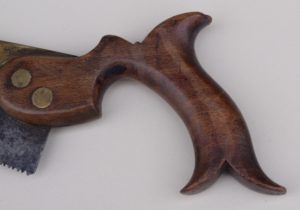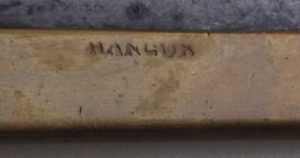
Upon first sight, the elongated, rounded boss indicated that this was an early saw, most likely from Birmingham. The ribbon cut in the handle end, centered as it is, was another feature more common to an early saw; I believe later saws tend to have the cut closer to the blade side.

As found, the 10” blade is very poorly sharpened. The handle is only ¾” thick, fastened with 3/8” split nuts. The small spine is only 3/16” thick and a little under 9/16” deep. Everything is minimal.
This is such a delicate saw. Holding the small handle is reminiscent of being a child and picking up a stick to pretend as a pistol. And yet it is sufficient for use.


The mark on the spine, Hancox, is stamped upside down and close to the handle. This unusual placement at first made me think it might have been stamped by an owner rather than the maker. All that Google initially revealed was that the name historically appears in both Birmingham and Newcastle, two early centers of saw production in England.
And then, on a New Years Day, I searched again and found success. On a site for Londonlives.org I found a record of a fire insurance policy for 700 pounds issued in 1781 to Joseph Hancox, sawmaker of Kinfare, Stafford, which is a little over 20 miles north of Birmingham.
Londonlives.org not only confirmed Hancox as the maker of this saw and Birmingham as the location, but also had many other listings giving names of previously unknown sawmakers, through insurance policies, court proceedings etc..
Wiktor Kuc, on seeing an image of this saw, commented that the cant of the blade seemed extreme, and thought that since the front and rear of the blade are at right angles to the toothline, the back was likely to be cut at an angle. Only removal of the spine could prove his hypothesis. In this case, rather than taking this old saw apart, I chose to leave the question unanswered.
